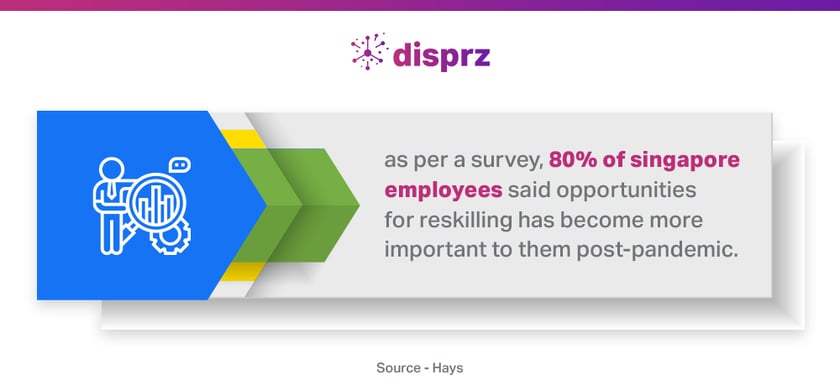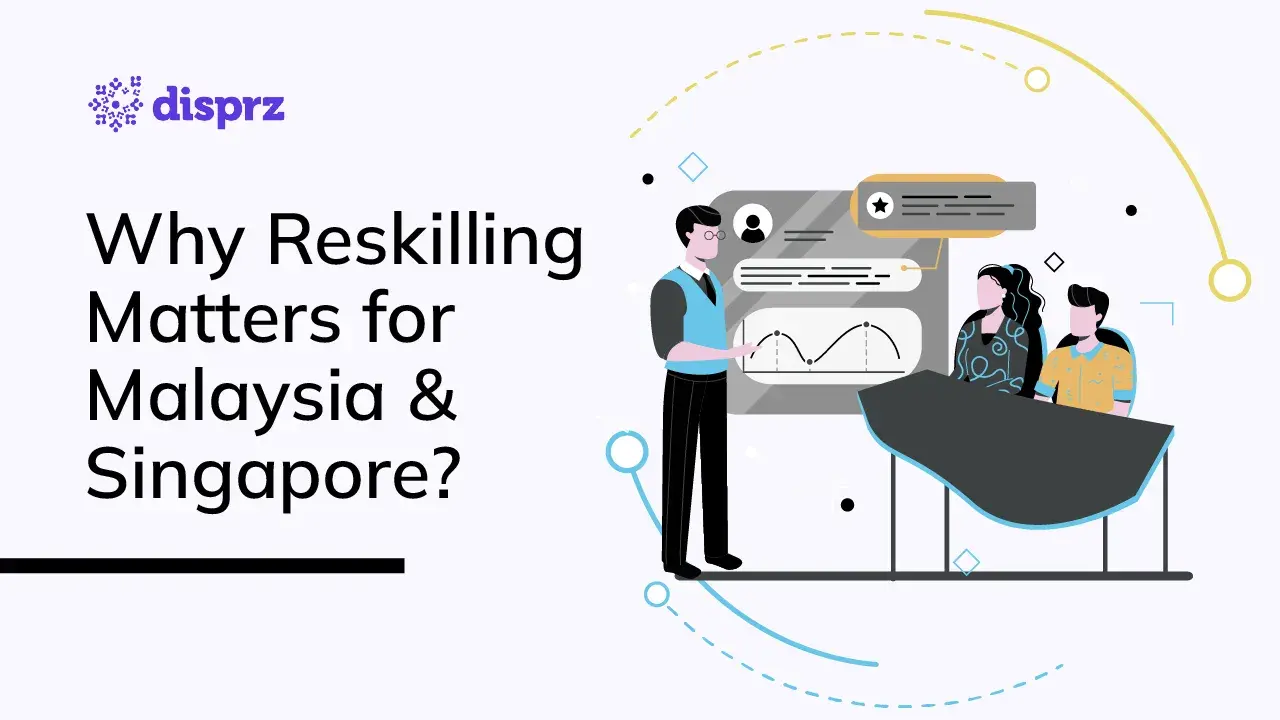Skills that helped Singapore and Malaysian companies capitalize on various opportunities in the past have become obsolete now. New job roles are evolving at a fast pace.
As per a study, 75 million to 375 million employees may need to switch occupational categories and learn new skills.
The future of work is very uncertain; reskilling is crucial to thrive and survive in the ever-changing economy.
The governments of Singapore and Malaysia have stepped in to support employee reskilling.
The Singapore Government has come up with a Skills Future initiative to fuel skill development. While Malaysia Digital Economy Corporation, a government agency partnered with Coursera to provide skill development opportunities to the Malaysian workforce. They are also implementing various plans to enhance the skills of Malaysian employees.
“To boost the skills and resilience of Malaysia’s workforce, a National Job Creation Strategic will be implemented. Creation of employment in Malaysia will also be enhanced through six core strategies, including to spur the growth of new and modern sectors, and to create skills and talents to meet the need of industries” quoted Ismail Sabri, Prime Minister of Malaysia in ET HR World South-East Asia.
Reskilling: The need of the hour for Malaysia and Singapore companies
A drastic transformation towards the digital economy blended with the disruption caused by the pandemic wreaked havoc on Malaysia and Singapore businesses. Most companies are experiencing a drop in employee performance due to which they aren’t able to meet the rising customer expectations. The development of new roles and responsibilities due to the Covid-19 crisis and digital disruption have posed more challenges for the employees. Several employees find it daunting to take up new tasks without the right skills. Reskilling has suddenly become the priority for most businesses and employees.

Even employees in Malaysia feel they need to expand their skill set for a smooth transition into new roles.
As per a survey conducted by Ranstad Malaysia, 89% of respondents said they would need to acquire new skills to work in a digital-led environment, while 93% said they were willing to acquire these skills themselves to guarantee their employability.
Rather than investing in hiring new employees, it is better to strengthen the current workforce and make them future-ready. Since the intent to learn is high, you can even boost employee retention by offering the right reskilling opportunities.
How to reskill and make employees future-ready?
Here are a few tips for reskilling and preparing your employees for the uncertain future.

Find out the new skills needed for each role
To adapt to the changing Singapore and Malaysian market trends, companies have walked the extra mile and explored new job roles to improve the bottom line.
Before putting your employees in those different roles, it is important to identify the various skills required to perform the specific job efficiently.
Through role-based skill benchmarking inside disprz, you can discover trending skills. Effortlessly identify and benchmark role-based functional, leadership, and digital skills for 2000+ job roles. Once you are aware of the skills needed for each role, it becomes easier to take the next step for reskilling your employees.
Plan your reskilling program
Planning is crucial to move forward in the right direction. Choose how you would like to train your employees; through in-person or virtual training.
Nowadays, most companies in Malaysia and Singapore are switching to virtual training and are implementing LMS to boost skill development.
LMS provides a wide array of features to supercharge employee learning and development. You can manage an employee's entire lifecycle from onboarding to taking him/her to the next level with an advanced LMS. Experiment with various formats like live sessions, videos, and blogs to boost adoption. LMS gives you the flexibility to blend the various formats to create a single learning pathway. For instance, you can plan the reskilling journey where the employee will first read a few documents, then watch some podcasts, and later take assessments to test their understanding of a specific subject. Systematic planning can save time and help create effective reskilling programs for employees to develop new skills and keep up with the changing trends.
Prepare training material and certification
Training materials are the core pieces of your reskilling program; they directly impact a course’s completion rate. If the content is not impactful or relevant, the employees will repel and not engage with it.
So how to make the training material effective?
Start by finding the objective of creating the training material, like who will be learning from the material and where they will apply what they’ve learned. Have clarity on the skills you would like to develop and explore various delivery methods like slide decks, video series, live webinars, etc, to make the L&D engaging.
Besides focusing on delivering impactful learning, it is even important to plan how to appreciate the efforts of the learners. Create various certificates for different skilling programs to motivate the employees to learn more and improve their skill set for undertaking different tasks
Coordinate and help employees visualize the benefits of investing time in reskilling
Most Singapore and Malaysian employees find it challenging to invest time in learning and development. They have too much on their plate, so they often skip various reskilling programs that affect their performance.
Therefore it is important to coordinate with the employees and help them understand how the reskilling programs will contribute to their professional growth. With the help of the data from the LMS, provide regular feedback to highlight the performance gaps and guide the employees on how reskilling can help in filling the gaps. Try to understand the learning needs of the employees. Find out what kind of learning they would be willing to be involved in. This will help in shaping engaging reskilling programs and even increase the adoption rate.
Measure and evaluate the success of your reskilling programs
You have been investing time and effort in creating reskilling programs but are you getting the desired results? Make sure you measure the effectiveness of your reskilling program to understand if employees are engaging or avoiding your programs.
With an analytics builder, you can keep track of various learning metrics to make real-time amendments. It enables you to convert raw data into actionable insights. You can get deeper insights into your learner behavior and usage patterns. You can know whether the employees are completing your courses. It allows you to track the login frequency and determine the time spent on each course. Based on this data, you can connect with your employees to discover the problem areas and optimize your reskilling programs accordingly.
Conclusion
Reskilling can help you in making the most of your existing resources. Employees feel valued when their current employer believes in them and gives them opportunities to elevate their position in the organization. The right learning tool can help you reskill and make your employees future-ready. An all-in-one solution like disprz that is packed with rich features can help you focus on the overgrowth of the employee. It even offers an AI-based LXP to personalize learning and take reskilling to the next level. You can effortlessly upskill and reskill your employees with this intuitive tool. Preview disprz to experience it in action.










